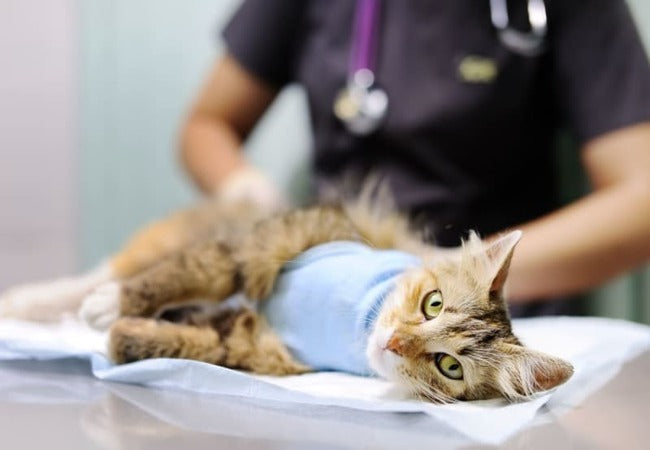Vet‑Approved 2025 Guide: PU Surgery & Recovery in Cats – Care, Comfort & Prevention 🐱💉

In this article
Vet‑Approved 2025 Guide: PU Surgery & Recovery in Cats – Care, Comfort & Prevention 🐱💉
By Dr. Duncan Houston BVSc
When your cat suffers repeat urethral blockages, a Perineal Urethrostomy (PU) surgery creates a new urinary opening to prevent future emergencies. While highly effective, the first few weeks of recovery are crucial for success. In this fully detailed 2025 guide, Dr. Duncan Houston BVSc explains why the procedure is done, what the surgery involves, how to manage recovery at home, and signs to watch closely—plus helpful tools like Ask A Vet, to support comfort and healing. 🐾✨
🔍 Why is PU Surgery Needed?
Male cats are prone to urethral blockages—strictures, stones, crystals—because of their narrow penile urethra. After two or more obstruction episodes, vets often recommend PU surgery to prevent recurrence. Unlike females with wider urethras, male cats benefit significantly from this procedure.
⚙️ What Happens During PU Surgery?
Cats are anesthetized and prepared for surgery. The penis is removed and the wider pelvic urethra is sutured to the skin, creating a new permanent urinary stoma. The procedure typically takes 1–2 hours, followed by a 24-hour catheterization to ensure flow.
💰 Hospital Stay & Immediate Post‑Op Care
- Cats stay hospitalized 1–2 days with IV fluids, pain relief, and careful catheter and stoma monitoring.
- You’ll likely start antibiotics, urinary acidifiers, and pain medications upon discharge.
🏠 Home Aftercare Setup
- Keep your cat indoors in a quiet, confined space (bathroom or bedroom) for 14–21 days.
- Use non-clumping paper or pelleted litter to avoid stoma irritation.
- Equip shallow bowls for food and water—placed near floor level—and use a comfortable e-collar or recovery suit to prevent licking.
🍽️ Feeding & Hydration Guidelines
- Encourage water intake via fountains or wet food to reduce crystal formation.
- Transition to a prescription urinary diet (e.g., Hill's C/D, Purina UR) to prevent future blockages.
🛡️ Activity Restrictions
- No jumping, running, or stairs for the first 2–3 weeks.
- Confine your cat to a limited space to prevent exertion and track urination more easily.
⚕️ Incision & Stoma Monitoring
- Check daily for swelling, redness, discharge or suture loosening.
- Keep the stoma clean, dry, and protected—don’t bathe the area.
- Check for urine dribbling and bloody urine, which can persist for 3–5 days.
💊 Medications & Nutrition Support
- Avoid skipping antibiotics or NSAIDs—the full course protects stoma healing.
- Consider urethral relaxants and bladder support—like phenoxybenzamine or bladder wall protectants—if prescribed.
- Long‑term acidifying diet and hydration remain important post-recovery.
🔍 Follow-Up & Suture Removal
- Sutures are typically removed at 14–21 days post-op during a vet visit.
- Vet will check urine flow, examine stoma health, and may perform a urinalysis.
⚠️ Watch for Warning Signs
- Straining to urinate without producing urine for over 4–6 hours.
- Excessive discharge or swelling around the stoma/incision.
- Fever, lethargy, vomiting, diarrhea, or decreased appetite.
📈 Long‑Term Outlook
Most cats thrive after PU surgery:
- Survival averages 3–5 years post-op, with some living even longer.
- Recurrence of obstruction is rare, but UTIs are more common due to a widened urethra.
- With proper diet, hydration, and monitoring, quality of life is excellent.
🛠️ Comfort Tools & Supportive Aids
- Ask A Vet: Ideal for remote check-ins, photo uploads, or stoma monitoring without stress.
📞 When to Contact the Vet Immediately
- No urination for 4–6 hours after recovery starts.
- High fever, lethargy, persistent vomiting or diarrhea.
- Worsening or infected incision/stoma site.
- Loss of appetite for over 24 hours.
🏁 Final Thoughts
PU surgery gives cats relief from life-threatening obstructions. With careful home management—restricted activity, proper litter, concern for hydration and diet, and diligent monitoring—you set your cat on the path to a pain-free life. Integrating support from Ask A Vet, adds comfort during those early recovery weeks. Your vigilance and care ensure the best possible outcome—here’s to your feline friend’s healthier future! 🐱❤️


